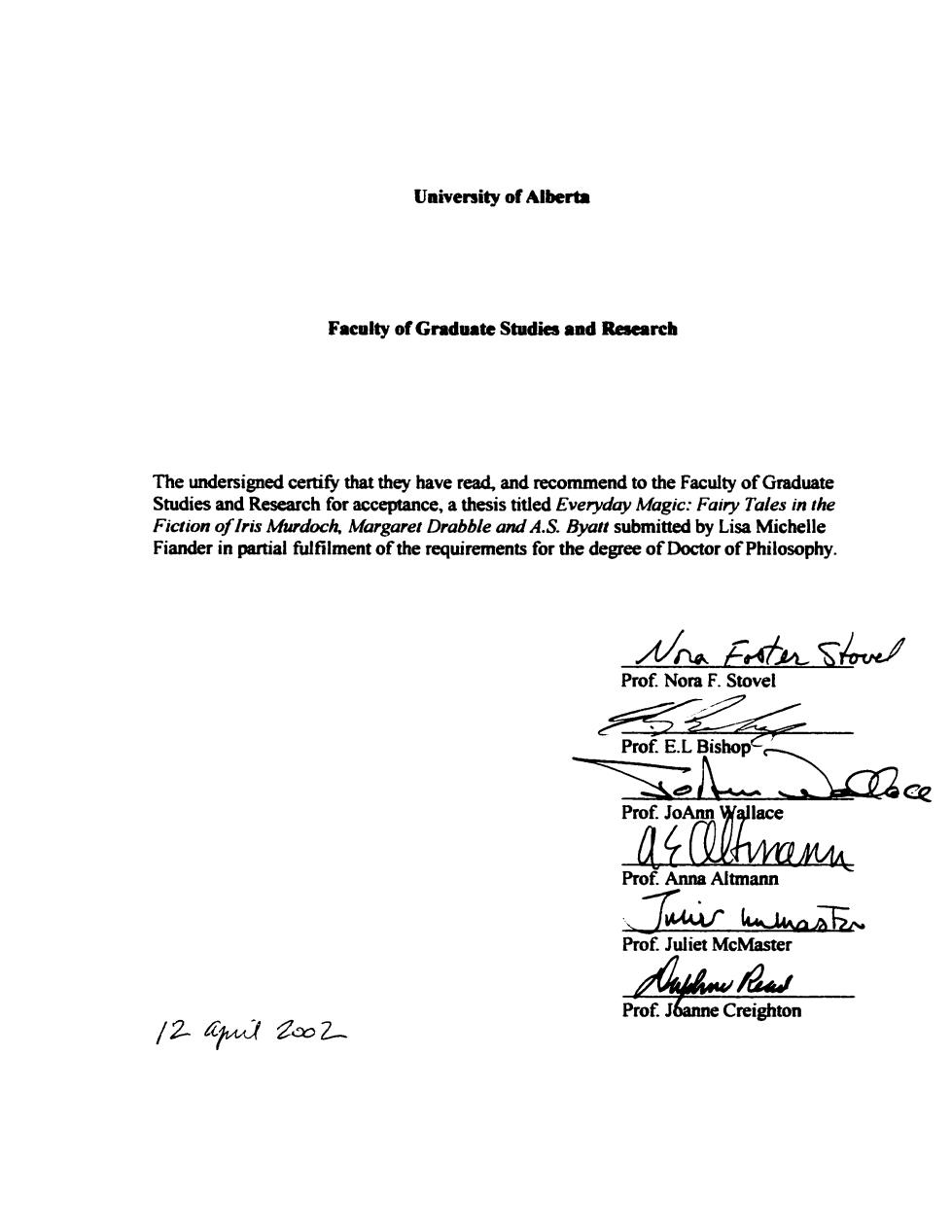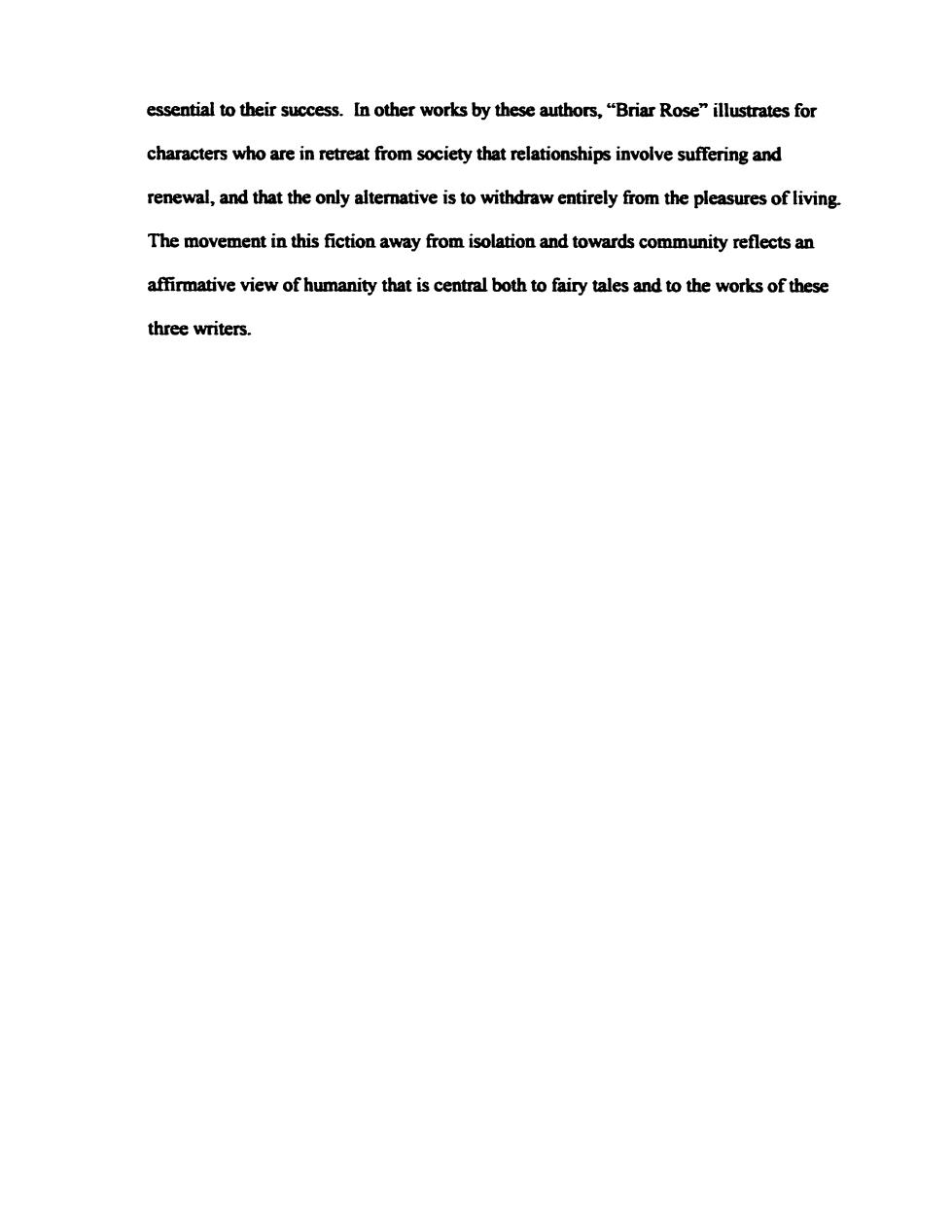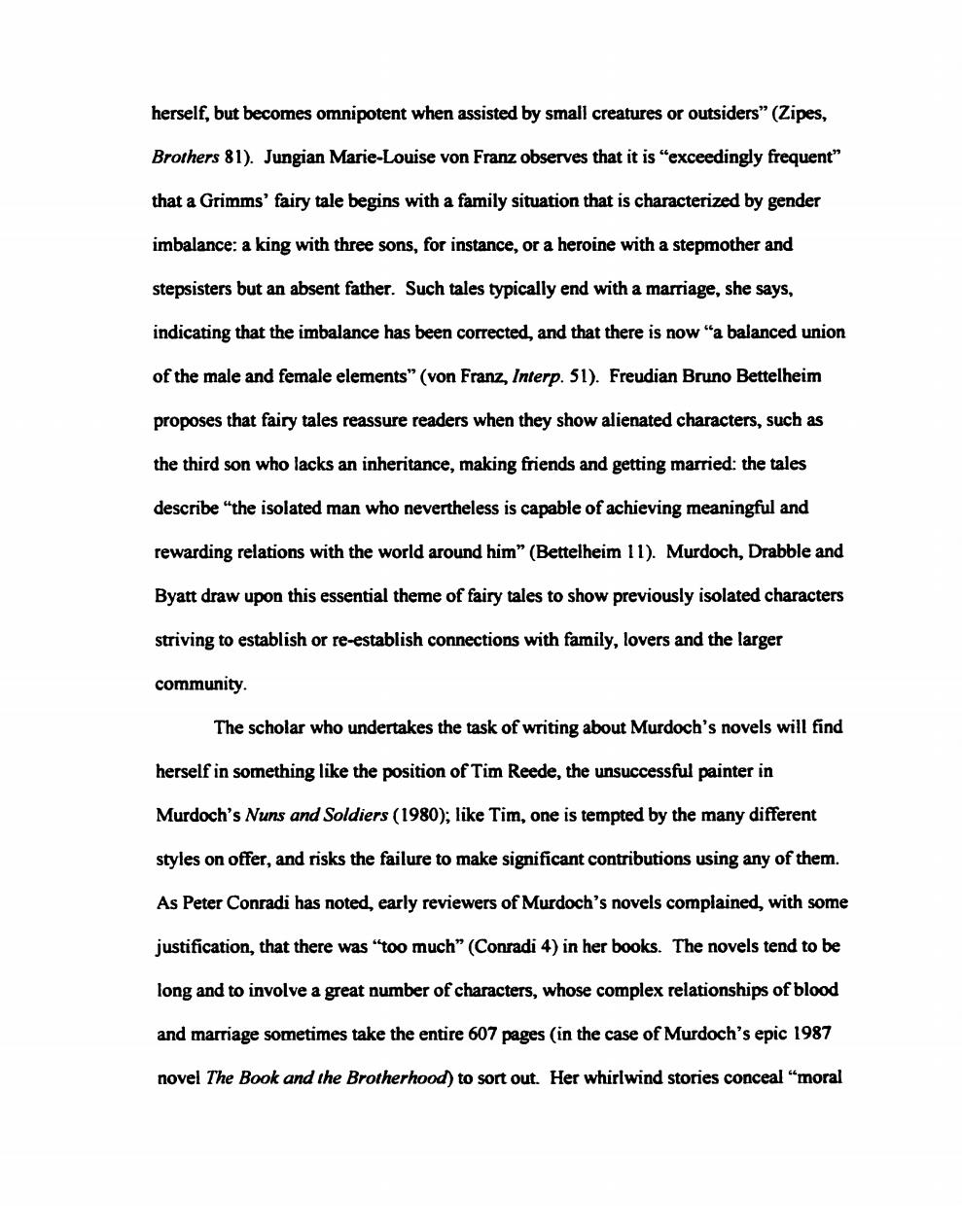
University of Alberta Faculty of Graduate Studies and Research The undersigned certify that they have read,and recommend to the Faculty of Graduate Studies and Research for acceptance,a thesis titled Everyday Magic:Fairy Tales in the Fiction of Iris Murdoch,Margaret Drabble and A.S.Byatt submitted by Lisa Michelle Fiander in partial fulfilment of the requirements for the degree of Doctor of Philosophy haEt么Shw Prof.Nora F.Stovel 、2之 Prof.E.L Bishop Prof.JoAnn Wallace 022m4 Prof.Anna Altmann l wan五 Prof.Juliet McMaster 4w尼u Prof.Joanne Creighton /241o2

Abstract Folklore scholars have identified the movement away from alienation and towards community as a nearly universal feature of fairy tales,and a characteristic of the German tales of Jacob and Wilhelm Grimm,among them.This dimension of fairy tales has made them useful to British writers Iris Murdoch,Margaret Drabble and A.S.Byatt,who highlight a similar drive towards community in their fiction.In the works of these writers,fairy tales inspire characters who have withdrawn from social engagements to seek out more meaningful connections with family,lovers and the wider community. The Grimm brothers'"Hansel and Gretel"acquaints child characters and their parents with the risks involved in intimate relationships,including the anxiety,resentment and guilt which can dominate those bonds.Like the heroine of the Grimms'"Cinderella," characters who have distanced themselves from their relatives in the course of achieving adulthood are subsequently compelled to confront the impact of family on their lives. Animal-bridegroom tales,such as the Grimms'"The Singing,Springing Lark,"and tales associated with them,such as“The Robber Bridegroom”and“Brother and Sister,”teach protagonists about the risks involved in romantic relationships,although love might also produce powerful changes in a character's life;some break the habit of solitude in order to love,taking a risk which connects them strongly with a network of obligations to others that Murdoch,Drabble and Byatt have said characterizes a moral world Elsewhere in the fiction of these writers,animal-bridegroom tales illuminate the conflict between selfhood and community.Finally,the tale "Briar Rose"enables Murdoch to explore romantic relationships and the autonomy and sense of equality that she feels are

essential to their success.In other works by these authors,"Briar Rose"illustrates for characters who are in retreat from society that relationships involve suffering and renewal,and that the only alterative is to withdraw entirely from the pleasures of living. The movement in this fiction away from isolation and towards community reflects an affirmative view of humanity that is central both to fairy tales and to the works of these three writers

Preface In Iris Murdoch's The Flight From the Enchanter(1955),the second of her 26 published novels,the mysterious Mischa Fox describes his belief in"the way in which magic can be part of ordinary life"(Murdoch,Flight 192).Murdoch(1919-1999),and her contemporaries Margaret Drabble (b.1939)and A.S.Byatt (b.1936),make reference to the magic of fairy tales in their fiction to show characters moving away from isolation and alienation and towards community.That journey,and the ways in which fairy tales are used by these authors to describe it,are,however,charged with ambivalence in the fiction.Characters in the works of these authors feel the attractions of a solitary existence.Many protagonists have a distant relationship with their families,are involved in romances that have been based on fantasy and illusion,and are anxious about participating in a wider community that will judge them.If certain characters surrender to the temptation to withdraw from the complexities of modern life,however,happiness in these novels seems to be reserved for those who resist.Furthermore,in the worlds described by these authors,the pursuit of relationships is intimately connected with a moral life.Although the three writers have stopped short of calling themselves optimists, their encouraging view of modern humanity,as inspired to seek out meaningful relationships with others despite the difficulty of those engagements,serves to set them apart somewhat from other contemporary British novelists. Folklore scholars have remarked on the movement towards community in fairy tales.Writing about the German fairy tales of the Grimm brothers,cultural materialist Jack Zipes notes,"It is interesting that the Grimm protagonist is nothing alone,by him or

herself,but becomes omnipotent when assisted by small creatures or outsiders"(Zipes, Brothers 81).Jungian Marie-Louise von Franz observes that it is"exceedingly frequent" that a Grimms'fairy tale begins with a family situation that is characterized by gender imbalance:a king with three sons,for instance,or a heroine with a stepmother and stepsisters but an absent father.Such tales typically end with a marriage,she says, indicating that the imbalance has been corrected,and that there is now"a balanced union of the male and female elements"(von Franz,Interp.51).Freudian Bruno Bettelheim proposes that fairy tales reassure readers when they show alienated characters,such as the third son who lacks an inheritance,making friends and getting married:the tales describe "the isolated man who nevertheless is capable of achieving meaningful and rewarding relations with the world around him"(Bettelheim 11).Murdoch,Drabble and Byatt draw upon this essential theme of fairy tales to show previously isolated characters striving to establish or re-establish connections with family,lovers and the larger community. The scholar who undertakes the task of writing about Murdoch's novels will find herself in something like the position of Tim Reede,the unsuccessful painter in Murdoch's Nuns and Soldiers(1980);like Tim,one is tempted by the many different styles on offer,and risks the failure to make significant contributions using any of them. As Peter Conradi has noted,early reviewers of Murdoch's novels complained,with some justification,that there was"too much"(Conradi 4)in her books.The novels tend to be long and to involve a great number of characters,whose complex relationships of blood and marriage sometimes take the entire 607 pages (in the case of Murdoch's epic 1987 novel The Book and the Brotherhood)to sort out.Her whirlwind stories conceal"moral